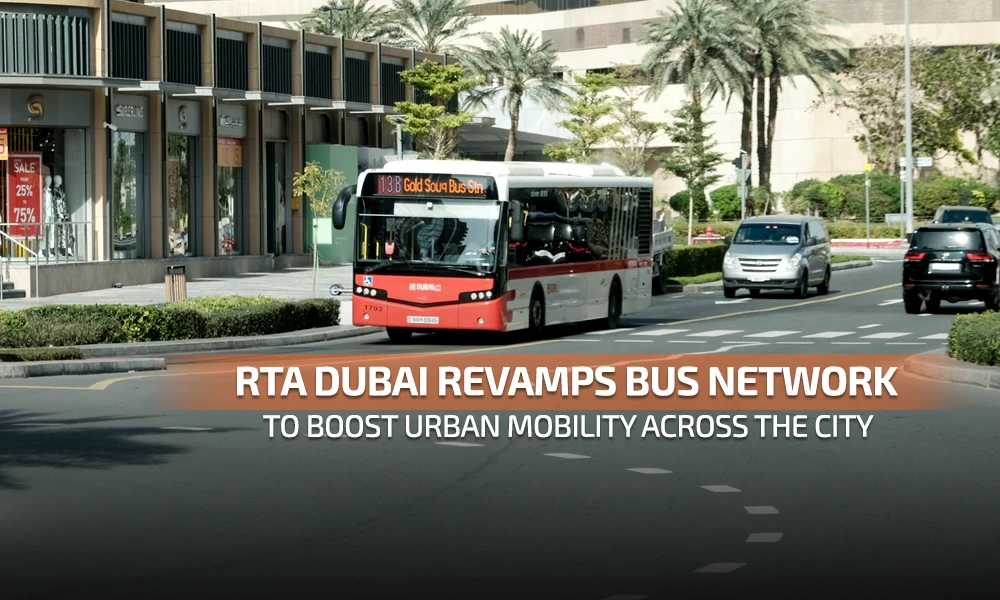Introduction: A Bold Move Toward Seamless Urban Connectivity
Dubai’s rapid growth demands smarter, faster, and more sustainable transit solutions. With this in mind, RTA Dubai (Roads and Transport Authority) has taken a monumental step forward by updating 13 major bus routes and adding new stops across the city. These updates are not just about buses—they’re about building a future-ready transportation ecosystem for one of the world’s fastest-evolving urban landscapes.
The recent updates reflect RTA’s strategic commitment to enhancing accessibility, reducing congestion, and creating a commuter-first approach to public transit in Dubai.
What’s New: Highlights of the RTA Bus Route Update
As reported by Khaleej Times and Curly Tales, RTA Dubai has implemented the following key changes:
- 13 routes updated to improve frequency and reduce travel time.
- New bus stops introduced in high-demand urban corridors.
- Integration of routes with Dubai Metro and Tram networks for smoother intermodal connections.
- Route enhancements focused on residential, commercial, and tourism-heavy zones such as Al Quoz, Business Bay, Jumeirah, and Dubai Marina.
This move is part of RTA’s continuous effort to make public transportation the preferred choice for both residents and tourists.
Why These Route Changes Matter
A Response to Population Growth and Commuter Demand
Dubai’s population is growing at a significant pace. With millions relying on public transport daily, the existing infrastructure needed realignment to meet rising demands. RTA Dubai responded with a data-driven approach—identifying bottlenecks, monitoring usage trends, and optimizing routes accordingly.
Less Waiting, More Moving
Reduced waiting times and more reliable frequencies mean commuters can now:
- Get to work on time without stress
- Plan their days better with consistent bus timings
- Explore more of the city without needing a car
This aligns perfectly with the RTA’s vision to transform Dubai into a smart, sustainable, and inclusive urban center.
A Closer Look at the Modified Routes
Some of the most impactful updates include:
- Route F55 – Extended to serve Al Maktoum International Airport and surrounding residential zones.
- Route 28 – Revised to cover Business Bay and Jumeirah in a more direct manner.
- Route 91A – Enhanced for better access to industrial zones, benefiting blue-collar commuters.
- Route E307A – Introduced new stops in densely populated residential areas for better reach.
These changes don’t just serve commuters—they reflect RTA’s strategy to balance economic development with commuter convenience.
Sustainability in Motion: RTA’s Eco-Transit Vision
RTA Dubai is also working aggressively toward environmental goals by:
- Deploying electric and hybrid buses into the network
- Implementing smart scheduling to minimize fuel waste
- Integrating solar-powered bus shelters
- Reducing single-occupancy vehicle dependency through more robust public transport options
The route updates are not standalone changes; they are part of RTA’s smart city framework that emphasizes efficiency, innovation, and sustainability.
RTA’s Broader Infrastructure Strategy – More Than Just Routes
RTA Dubai has been rolling out a range of complementary initiatives to support these bus route changes:
- Construction of dedicated bus lanes to reduce delays during peak hours.
- Real-time tracking through the S’hail App, allowing commuters to plan better.
- Expansion of park-and-ride facilities to encourage a multi-modal travel culture.
- Revamped signage and interactive kiosks for tourist-friendly navigation.
Together, these moves position RTA Dubai as a regional pioneer in public mobility transformation.
How These Changes Benefit the Average Commuter
Whether you’re a student, office-goer, tourist, or a worker, these RTA changes bring real-life benefits:
- Faster Commutes: Optimized routes shave off minutes from daily travel.
- Greater Reach: More stops mean less walking and more convenience.
- More Reliable Timings: Consistent schedules reduce uncertainty and stress.
- Lower Costs: With better access to buses, fewer residents need private cars or taxis.
By putting people at the center, RTA Dubai is ensuring that mobility is no longer a luxury—it’s a reliable everyday service.
Public Response and What’s Next
So far, the public reception has been largely positive, with many commuters appreciating the reduced waiting time and seamless connectivity. However, RTA is not stopping here.
Planned initiatives include:
- More AI-driven planning tools to optimize future routes.
- Electric-only routes in eco-sensitive districts.
- Introduction of double-decker buses for high-traffic areas.
The road ahead is ambitious, and if current trends are anything to go by, RTA Dubai is more than capable of delivering.
FAQs:
RTA Dubai updated 13 bus routes and added new stops to improve citywide connectivity.
To reduce travel time, improve frequency, and enhance commuter convenience.
Key areas include Al Quoz, Jumeirah, Business Bay, Dubai Marina, and residential zones.
Multiple new stops were added across busy corridors to improve access.
Yes, it’s part of RTA’s smart mobility and sustainability vision for Dubai.
Conclusion: Smarter Mobility for a Smarter City
Dubai’s reputation as a global smart city is closely tied to how its residents move. With the latest bus route updates, RTA Dubai has reaffirmed its commitment to building a more connected, accessible, and sustainable city.
These updates are not mere tweaks; they’re a transformation of Dubai’s mobility philosophy. Through intelligent planning, tech-driven insights, and commuter-first designs, RTA continues to redefine what public transport can achieve in the 21st century.







